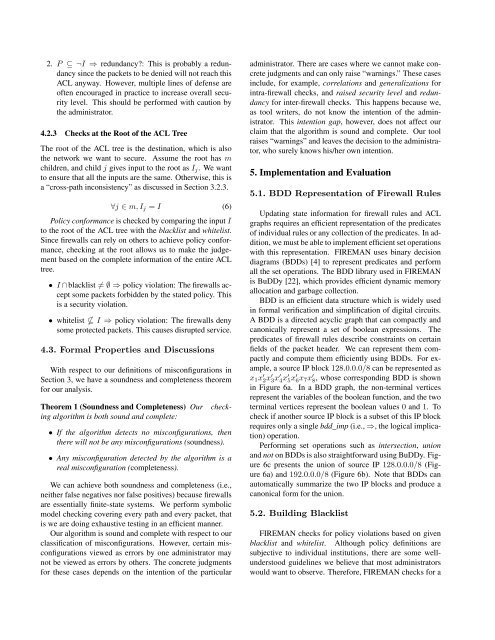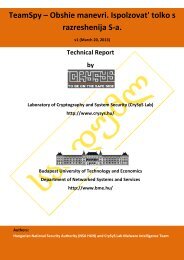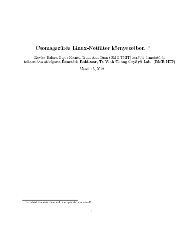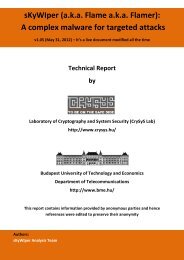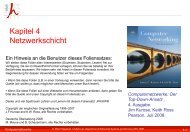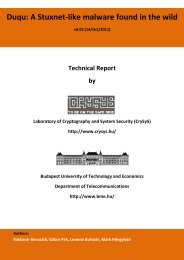FIREMAN: A Toolkit for FIREwall Modeling and ANalysis
FIREMAN: A Toolkit for FIREwall Modeling and ANalysis
FIREMAN: A Toolkit for FIREwall Modeling and ANalysis
You also want an ePaper? Increase the reach of your titles
YUMPU automatically turns print PDFs into web optimized ePapers that Google loves.
2. P ⊆ ¬I ⇒ redundancy?: This is probably a redundancy<br />
since the packets to be denied will not reach this<br />
ACL anyway. However, multiple lines of defense are<br />
often encouraged in practice to increase overall security<br />
level. This should be per<strong>for</strong>med with caution by<br />
the administrator.<br />
4.2.3 Checks at the Root of the ACL Tree<br />
The root of the ACL tree is the destination, which is also<br />
the network we want to secure. Assume the root has m<br />
children, <strong>and</strong> child j gives input to the root as Ij. We want<br />
to ensure that all the inputs are the same. Otherwise, this is<br />
a “cross-path inconsistency” as discussed in Section 3.2.3.<br />
∀j ∈ m, Ij = I (6)<br />
Policy con<strong>for</strong>mance is checked by comparing the input I<br />
to the root of the ACL tree with the blacklist <strong>and</strong> whitelist.<br />
Since firewalls can rely on others to achieve policy con<strong>for</strong>mance,<br />
checking at the root allows us to make the judgement<br />
based on the complete in<strong>for</strong>mation of the entire ACL<br />
tree.<br />
• I ∩ blacklist = ∅ ⇒ policy violation: The firewalls accept<br />
some packets <strong>for</strong>bidden by the stated policy. This<br />
is a security violation.<br />
• whitelist I ⇒ policy violation: The firewalls deny<br />
some protected packets. This causes disrupted service.<br />
4.3. Formal Properties <strong>and</strong> Discussions<br />
With respect to our definitions of misconfigurations in<br />
Section 3, we have a soundness <strong>and</strong> completeness theorem<br />
<strong>for</strong> our analysis.<br />
Theorem 1 (Soundness <strong>and</strong> Completeness) Our checking<br />
algorithm is both sound <strong>and</strong> complete:<br />
• If the algorithm detects no misconfigurations, then<br />
there will not be any misconfigurations (soundness).<br />
• Any misconfiguration detected by the algorithm is a<br />
real misconfiguration (completeness).<br />
We can achieve both soundness <strong>and</strong> completeness (i.e.,<br />
neither false negatives nor false positives) because firewalls<br />
are essentially finite-state systems. We per<strong>for</strong>m symbolic<br />
model checking covering every path <strong>and</strong> every packet, that<br />
is we are doing exhaustive testing in an efficient manner.<br />
Our algorithm is sound <strong>and</strong> complete with respect to our<br />
classification of misconfigurations. However, certain misconfigurations<br />
viewed as errors by one administrator may<br />
not be viewed as errors by others. The concrete judgments<br />
<strong>for</strong> these cases depends on the intention of the particular<br />
administrator. There are cases where we cannot make concrete<br />
judgments <strong>and</strong> can only raise “warnings.” These cases<br />
include, <strong>for</strong> example, correlations <strong>and</strong> generalizations <strong>for</strong><br />
intra-firewall checks, <strong>and</strong> raised security level <strong>and</strong> redundancy<br />
<strong>for</strong> inter-firewall checks. This happens because we,<br />
as tool writers, do not know the intention of the administrator.<br />
This intention gap, however, does not affect our<br />
claim that the algorithm is sound <strong>and</strong> complete. Our tool<br />
raises “warnings” <strong>and</strong> leaves the decision to the administrator,<br />
who surely knows his/her own intention.<br />
5. Implementation <strong>and</strong> Evaluation<br />
5.1. BDD Representation of Firewall Rules<br />
Updating state in<strong>for</strong>mation <strong>for</strong> firewall rules <strong>and</strong> ACL<br />
graphs requires an efficient representation of the predicates<br />
of individual rules or any collection of the predicates. In addition,<br />
we must be able to implement efficient set operations<br />
with this representation. <strong>FIREMAN</strong> uses binary decision<br />
diagrams (BDDs) [4] to represent predicates <strong>and</strong> per<strong>for</strong>m<br />
all the set operations. The BDD library used in <strong>FIREMAN</strong><br />
is BuDDy [22], which provides efficient dynamic memory<br />
allocation <strong>and</strong> garbage collection.<br />
BDD is an efficient data structure which is widely used<br />
in <strong>for</strong>mal verification <strong>and</strong> simplification of digital circuits.<br />
A BDD is a directed acyclic graph that can compactly <strong>and</strong><br />
canonically represent a set of boolean expressions. The<br />
predicates of firewall rules describe constraints on certain<br />
fields of the packet header. We can represent them compactly<br />
<strong>and</strong> compute them efficiently using BDDs. For example,<br />
a source IP block 128.0.0.0/8 can be represented as<br />
x1x ′ 2x ′ 3x ′ 4x ′ 5x ′ 6x7x ′ 8, whose corresponding BDD is shown<br />
in Figure 6a. In a BDD graph, the non-terminal vertices<br />
represent the variables of the boolean function, <strong>and</strong> the two<br />
terminal vertices represent the boolean values 0 <strong>and</strong> 1. To<br />
check if another source IP block is a subset of this IP block<br />
requires only a single bdd_imp (i.e., ⇒, the logical implication)<br />
operation.<br />
Per<strong>for</strong>ming set operations such as intersection, union<br />
<strong>and</strong> not on BDDs is also straight<strong>for</strong>ward using BuDDy. Figure<br />
6c presents the union of source IP 128.0.0.0/8 (Figure<br />
6a) <strong>and</strong> 192.0.0.0/8 (Figure 6b). Note that BDDs can<br />
automatically summarize the two IP blocks <strong>and</strong> produce a<br />
canonical <strong>for</strong>m <strong>for</strong> the union.<br />
5.2. Building Blacklist<br />
<strong>FIREMAN</strong> checks <strong>for</strong> policy violations based on given<br />
blacklist <strong>and</strong> whitelist. Although policy definitions are<br />
subjective to individual institutions, there are some wellunderstood<br />
guidelines we believe that most administrators<br />
would want to observe. There<strong>for</strong>e, <strong>FIREMAN</strong> checks <strong>for</strong> a


